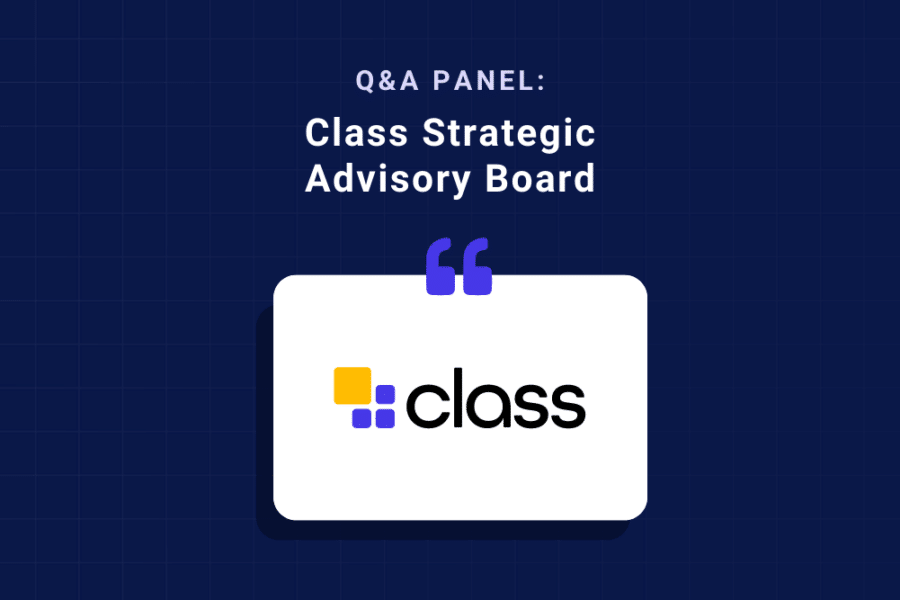
Jamie Turak is an Education Content Manager at Class. He's passionate about storytelling and helping to make education more accessible.

Jamie Turak is an Education Content Manager at Class. He's passionate about storytelling and helping to make education more accessible.

Recently, the Class Strategic Advisory Board convened to discuss the future of virtual, hybrid, and HyFlex education. In this blog post, learn how leaders in K-12 and higher education calibrate new expectations for learning in an era redefining education’s future.
Regardless of where students learn, educators are now providing comprehensive, engaging learning experiences in multiple modalities to expand reach, enhance access, and ensure diverse learning opportunities for all students.
As the Class Strategic Advisory Board discussed the future of online, hybrid, and HyFlex education, a series of priorities were identified. There is a strong need to build community in an online environment to ensure opportunities and equity for all learners and an authentic environment for students to succeed.
The panel agreed that video conferencing alone is no longer enough to lead an effective online, hybrid, or HyFlex course. Online learning has accelerated over the past five years, and standards have risen. Now, students expect more than just flexibility from hybrid or HyFlex education. They want the virtual experience to be as rich and thought-provoking as traditional in-person offerings.
Dr. Morcease Beasley, Superintendent at Clayton County Public Schools, says that typical video conferencing isn’t a tool that allows institutions to plan for the learning experience. It doesn’t allow instructors to provide courses with quality, intention, and purpose. Students need to feel secure, confident, and in control of their learning while also feeling that they can be vulnerable in their learning space.
Amy McGrath, Chief Operating Officer at ASU Preparatory Academy, states that mastery learning happens in the community- beyond just a physical presence next to someone. Learners need to be interdependent. Applying the knowledge they’ve gained in their independent learning needs to be turned into real-world conversations, which means interacting with other people. This requires web conferencing tools to be full of features and tools that enable these community-based, authentic learning experiences.
As more students choose to learn partially or fully online, educators face the challenge of building a community that often exists organically in an in-person setting. Eric Waldo, Chief Engagement Officer for the US Surgeon General, states that learners want to feel community and connection authentically, even in a virtual environment. Learning online should feel fun and exciting, and this happens through creativity.
It is important that learners feel they are active members of their learning community, says Peggy Brookins, President and CEO of the National Board for Professional Teaching Standards. Amy McGrath adds that it is important that learners need to feel seen beyond just what is seen through cameras. They need to have the opportunity to apply learning in a way that creates a connection with their online learning community.
Virtual learning can help to expand the world for all students, which increases equity and access across the board. But it is not enough just to offer online courses. A deliberate focus on providing an even playing field for all students – especially those from underserved populations – must also be made in online courses. Dr. Morcease Beasly asks, “How can tools begin to create an environment where a student feels secure, confident, and in control of their learning, but also feel they can be vulnerable in the learning space they are in?” Eric Waldo states that online learning allows institutions to find the best instructors and truly unlock their potential and allow them to impact a high number of students from multiple locations.
Through online learning, there is also the potential to activate students who may not thrive in the physical classroom. Audrey Witters, Managing Director, Online & Entrepreneurship Programs at Stanford Graduate School of Business Executive Education, states that we can help create intrinsic motivation for students to engage with their learning in ways they decide. Students want choices, and the more they can be provided, the more they become motivated to succeed.
The accelerated pace of learning will continue at all levels of education. Institutions must continue evolving to meet all students’ needs while providing a holistic, supportive outlook on shaping a student academically, personally, and professionally.

Jamie Turak is an Education Content Manager at Class. He's passionate about storytelling and helping to make education more accessible.

Jamie Turak is an Education Content Manager at Class. He's passionate about storytelling and helping to make education more accessible.
Get our insights, tips, and best practices delivered to your inbox

Sign up for a product demo today to learn how Class’s virtual classroom powers digital transformation at your organization.

Features
Products
Integrations